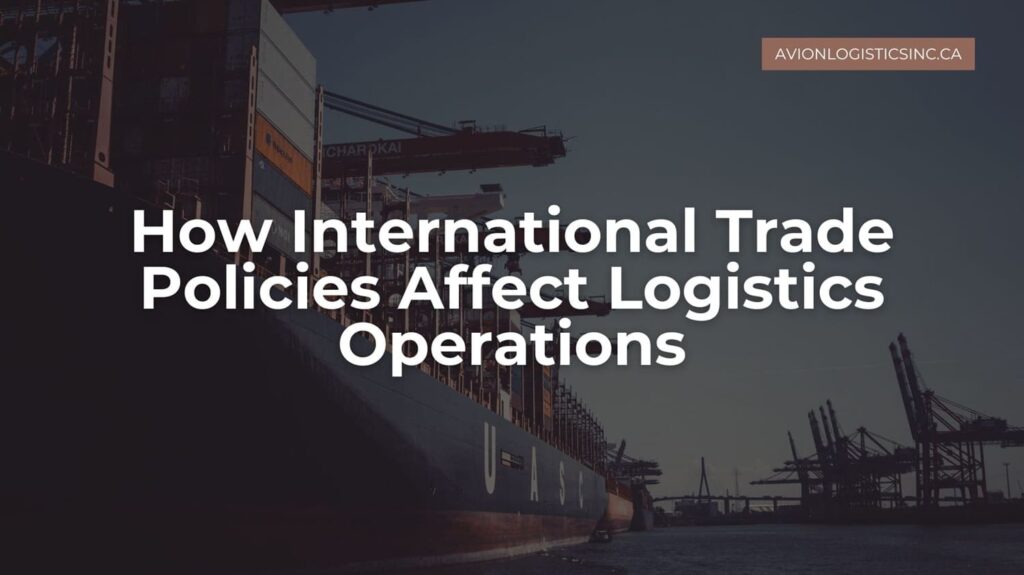
In today’s hyper-connected world, international trade plays a critical role in shaping economies. Behind the scenes, logistics operations work tirelessly to ensure goods move smoothly across countries and continents. However, the engine of global trade doesn’t run in isolation. It’s powered—and sometimes constrained—by international trade policies.
From tariffs and sanctions to free trade agreements and regulatory frameworks, these policies create a complex network of rules that logistics companies must navigate. Understanding how these policies affect transportation, warehousing, customs clearance, and overall supply chain efficiency is essential for businesses that operate across borders.
In this article, we explore the impact of international trade policies on logistics operations, key challenges they introduce, and strategies businesses can use to adapt and thrive.
1. Tariffs and Duties: Driving Up Logistics Costs
Tariffs are one of the most visible tools of international trade policy. These are taxes imposed on imported or exported goods and are often used to protect domestic industries or retaliate against other countries’ trade practices.
Logistics Impacts:
1. Higher Shipping Costs: Tariffs directly increase the cost of importing/exporting goods, making logistics more expensive.
2. Route Reconfiguration: Companies may choose alternate shipping routes or shift suppliers to countries with lower tariffs.
3. Paperwork and Delays: Calculating duties, filing forms, and clearing customs becomes more complex, potentially slowing down supply chains.
Example: During the U.S.-China trade war, many American businesses rerouted supply chains to Southeast Asian countries to avoid high tariffs, significantly impacting shipping lanes, warehousing needs, and freight demand.
2. Free Trade Agreements (FTAs) and Trade Blocs
Trade agreements reduce or eliminate barriers to trade between countries. These agreements offer massive benefits to logistics by simplifying processes and cutting costs.
Examples of FTAs:
1. USMCA (United States-Mexico-Canada Agreement)
2. European Union Single Market
3. Comprehensive and Progressive Agreement for Trans-Pacific Partnership (CPTPP)
Logistics Benefits:
1. Faster Border Clearance: Less red tape means quicker customs processing.
2. Reduced Costs: No or low tariffs make importing/exporting more affordable.
3. Standardized Documentation: Reduces confusion and risk of non-compliance.
Strategic Opportunity:
Logistics providers operating in regions governed by FTAs can offer more competitive services by optimizing routes and consolidating freight hubs across borders.
3. Customs Regulations and Trade Compliance
Every country enforces its own set of customs regulations, dictated by national trade policy. These rules govern the classification, valuation, and documentation of goods moving across borders.
Key Factors:
1. Import/Export Licensing
2. Product-Specific Regulations (e.g., pharmaceuticals, electronics, chemicals)
3. Origin Certification
4. Security Screening (CTPAT, AEO)
Logistics Challenges:
1. Complexity: Different countries require different sets of paperwork, which can create bottlenecks.
2. Inspections: Non-compliant shipments may face lengthy inspections, causing delivery delays.
3. Fines and Penalties: Misdeclaration or improper documentation can lead to financial losses.
Solution: Partnering with experienced customs brokers or investing in automated trade compliance software can mitigate these risks.
4. Sanctions, Embargoes, and Restricted Countries
Governments often impose trade sanctions and embargoes to exert pressure for political or security reasons. These restrictions can prohibit or limit trade with specific countries, companies, or individuals.
Logistics Implications:
1. Shipping Restrictions: Logistics firms must avoid shipping goods to blacklisted destinations or entities.
2. Cargo Redirection: Carriers may need to reroute or offload cargo bound for sanctioned locations.
3. Increased Due Diligence: Enhanced screening and legal compliance checks are needed to avoid reputational and legal risks.
Case Study: In response to the Russia-Ukraine conflict, many Western nations imposed trade sanctions on Russian goods, leading to rerouted maritime traffic and disruptions in the availability of certain commodities like oil and fertilizer.
5. Political Shifts and Policy Uncertainty
Global trade is inherently political. A change in administration, a diplomatic dispute, or even a national referendum can suddenly reshape international trade policies and throw logistics operations into disarray.
Common Examples:
1. Brexit: The UK’s exit from the EU led to new customs rules and border controls, disrupting logistics across Europe.
2. Protectionist Policies: Countries raising tariffs or localizing manufacturing can shrink international shipping volumes.
Logistics Strategy:
To stay resilient, companies must develop contingency plans, diversify suppliers, and closely monitor global trade developments.
6. Environmental and Sustainability-Driven Trade Regulations
With growing concerns about climate change, environmental policies are becoming an integral part of international trade regulations. Governments are increasingly linking trade policy with environmental goals.
Regulations Include:
1. Carbon Border Adjustment Mechanisms (CBAMs)
2. Fuel Emission Standards
3. Green Port Initiatives
Logistics Impact:
1. Fleet Modernization: Logistics companies may need to invest in electric or low-emission vehicles and vessels.
2. Route Optimization: Reducing emissions through efficient route planning and load consolidation.
3. Reporting and Certification: Companies must track and report emissions or acquire green logistics certifications (ISO 14001, LEED, etc.)
7. Supply Chain Diversification and Risk Mitigation
Trade policies can make certain routes or partners less attractive due to new tariffs, sanctions, or compliance requirements. This prompts businesses to rethink their supply chains entirely.
Logistics Trends:
1. Nearshoring: Bringing suppliers closer to reduce dependency on volatile trade routes.
2. Multimodal Shipping: Combining air, rail, sea, and truck freight to create more flexible logistics networks.
3. Distributed Warehousing: Locating warehouses in strategic global regions to reduce customs delays and shipping times.
By diversifying their supply chain logistics, companies can better handle policy-related disruptions and maintain service levels.
8. Digital Tools and Regulatory Compliance Technology
With the complexity of international trade policy constantly evolving, logistics firms are turning to technology to stay compliant and efficient.
Digital Solutions:
1. Global Trade Management (GTM) Software
2. Customs Documentation Automation
3. Real-Time Shipment Tracking
4. Artificial Intelligence for Risk Detection
Benefits:
1. Reduced Human Error
2. Faster Documentation
3. Real-Time Regulatory Updates
4. Lower Compliance Costs
Example Tools: SAP Global Trade Services, Oracle GTM, Descartes Systems, and project44 are helping logistics businesses align with evolving trade policy landscapes.
9. Impact on SMEs and E-commerce Logistics
While large corporations can afford to navigate trade complexities, small and medium-sized enterprises (SMEs) often struggle more with the burden of compliance.
E-commerce Challenge:
Online sellers using platforms like Amazon, Etsy, or Shopify face:
1. Complicated tax rules
2. Cross-border return issues
3. Customs clearance delays
Logistics Providers’ Role:
Logistics firms offering cross-border e-commerce solutions must provide simplified services, such as:
1. DDP (Delivered Duty Paid) shipping
2. International warehousing
3. Integrated customs clearance
Helping SMEs and online retailers comply with trade policies can be a major differentiator for modern logistics businesses.
10. Future Outlook: How Logistics Can Adapt to Changing Trade Policies
As international trade policies continue to evolve, logistics operations must remain agile, informed, and proactive. Key future trends include:
1. Digitally Integrated Supply Chains: Real-time visibility and predictive analytics will help logistics firms stay ahead of policy changes.
2. Collaborative Trade Ecosystems: Governments and companies will work more closely to align trade regulations with logistics capabilities.
3. Sustainability-Driven Logistics: Trade policies will increasingly prioritize carbon neutrality and ethical sourcing.
Final Thought:
Logistics companies that invest in technology, regulatory expertise, and supply chain flexibility will not only survive global trade disruptions—they’ll thrive.
FAQs
1. What are international trade policies?
They are laws and agreements that govern how countries conduct import/export activities. These policies affect tariffs, customs, documentation, and allowed trade partners.
2. Why are tariffs important in logistics?
Tariffs raise the cost of goods being moved, impacting total shipping costs and requiring logistics companies to reroute or rethink supply chain plans.
3. How can FTAs help logistics companies?
They simplify customs processes, reduce tariffs, and open up new markets with standardized regulations, making international shipping easier and more cost-effective.
4. What tools help with trade compliance in logistics?
GTM software, customs automation tools, AI-based risk analysis, and real-time shipment trackers help logistics firms stay compliant and efficient.
5. How do sanctions affect logistics?
Sanctions can block trade routes, restrict shipping destinations, and require enhanced vetting to avoid violating international laws.
Conclusion
International trade policies are powerful forces that can shape, disrupt, or enhance logistics operations across the globe. From tariffs and FTAs to sanctions and environmental regulations, these policies directly affect how and where goods move.
To remain competitive, logistics companies must:
- Understand and anticipate policy changes.
- Invest in compliance systems and expert talent.
- Build flexible, diversified supply chains.
- Leverage digital tools to optimize operations.
By aligning logistics strategies with global trade policies, businesses can navigate challenges with confidence and turn obstacles into opportunities.


